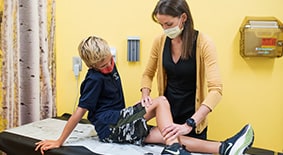The anterior cruciate ligament (ACL) is one of four main knee ligaments and acts to stabilize the knee. The ACL runs diagonally in the middle of the knee and connects the thighbone (femur) to the shinbone (tibia). It is one of the most commonly injured knee ligaments.
What causes an ACL injury?
ACL injuries most commonly occur as a noncontact injury in sports when a child or teen is making a cutting and pivoting movement or when he is jumping and landing. They can also occur as a result of a contact injury, such as during a tackle in soccer or a collision in football.
The athletes with the highest risk to get an ACL injury are teenagers. Girls ages 13 to 15 and boys ages 14 to 16 are at high risk for ACL injuries due to rapid growth—an athlete’s muscles having to “catch up” with his or her growth in height—increased time playing a sport and longer sports seasons.
Kids who play the following sports are more likely to have an ACL injury: soccer, basketball, football, lacrosse, gymnastics and competitive cheer.Are girls more likely to tear an ACL than boys?
Girls are four to eight times more likely to suffer an ACL injury than boys. There are many factors thought to contribute to this increased risk, many of which are related to differences in anatomy as well as jumping and landing mechanics. Some of these differences include:
- Hips: Girls have wider hips than boys, which increases the angle on the knee joint. This can put increased force on the ACL, especially with jumping and landing and with cutting movements. The strength of the hip, core and thigh muscles are important to stabilize the knee while a child is jumping and landing. These muscles are frequently weak or imbalanced in teenage athletes.
- Knees: The ACL passes through the middle of the knee in an area called the intercondylar notch. Girls have a narrower notch on the inside of their knee, which leaves their ACL more subject to getting injured during sudden stops or direction changes.
- Quadriceps: Hamstrings (muscles in the back of the thigh) protect the ACL. Quadriceps (muscles in the front of the thigh) put stress on the ACL. A girl’s quadriceps are typically stronger than her hamstrings, which make the ACL vulnerable to injury.
Growing athletes who tear their ACL may or may not have symptoms, depending on the severity of the injury.
- Most children say they heard a “pop” sound when they were injured, which is the sound of the ligament tearing.
- Athletes sometimes report a sensation that their knee has “given out.”
- There is often pain and swelling of the knee joint within 24 hours of the injury.
Can you walk with a torn ACL?
Yes. The ACL is important for stabilizing the knee while an athlete is running, jumping and playing sports but not when walking on flat ground. As the initial swelling and bruising improves, the knee typically feels much better, and patients have no difficulty walking. Many athletes will report that their knee “feels normal,” and they may be tempted to return to sports after several days. However, returning to a sport can be dangerous and may result in further injury to the knee cartilage, meniscus and other ligaments.
At Children’s Healthcare of Atlanta, our team of orthopedic and sports medicine experts will examine your child to assess knee swelling, motion, pain and stability of the ligaments to better understand the injury. Imaging tests, including an X-ray and MRI, will also be ordered. An X-ray is used to check for fractures, as well as examining growth plates in the knee. The MRI allows our specialists to look more closely at the meniscus, cartilage and ligaments.
Our orthopedics and sports medicine surgeons treat ACL injuries in children, teens and young adults from birth to age 18. We understand a child’s development, including how to properly care for growth plates, and injury prevention is our specialty.
Oftentimes, when a child’s or teen’s ACL is injured, it is completely torn. This means the two ends of the ACL shrivel up and will not grow back together. A torn ACL leaves the knee unstable and at risk for further shifting and can cause damage to the cartilage and meniscus. The best treatment option for a growing athlete who has a complete ACL tear is surgery to make a new ACL. This is called an ACL reconstruction surgery.
What is pediatric ACL surgery?
Pediatric ACL surgery is an arthroscopic surgery in which small incisions are made around the knee to help create a new ligament that will replace the torn ACL. The new ligament is most commonly made from your child’s own tendons, such as the quadriceps (front of the thigh), iliotibial (IT) band, patella (kneecap) or hamstring (posterior thigh muscle). The new ACL graft is anchored to the thighbone and shinbone. During ACL surgery, your child’s surgeon will also treat any other ligament, meniscus or cartilage injuries. The surgery is most commonly an outpatient procedure (no overnight hospital stay) and lasts about two hours.
If my child is still growing and my doctor recommended waiting several years to have ACL surgery, what should I do?
We recommend a comprehensive evaluation by one of our sports medicine ACL experts at Children’s.
In years past, pediatric ACL surgery performed on a growing athlete was often delayed for several years due to concerns about the risk of damaging growth plates. Multiple research studies have shown that delaying surgery to wait for children and teens to finish growing causes more damage in the knee to the cartilage, meniscus and sometimes the other ligaments, such as the posterior cruciate ligament (PCL), medial collateral ligament (MCL) or lateral collateral ligament (LCL). Our sports medicine surgeons specialize in performing ACL surgeries and use proven techniques to avoid growth plate injuries. This allows your child or teen to have a stable knee, avoid further knee damage and return to sports.
Is ACL surgery different for children and teens than adults?
A child’s or teen’s bones, ligaments and muscles are commonly still growing, which makes it important to treat children and teens differently from adults with an ACL injury. Our pediatric sports medicine surgeons assess each patient’s skeletal maturity and the amount of growing he has left and then make specialized treatment recommendations for an injury repair. This may include unique ACL reconstruction surgeries for even the youngest athletes so that we avoid any injury to growing bones.
Why choose Children’s for pediatric ACL surgery?
It’s important for children and teens to see a sports medicine team that is trained in pediatrics—and one that understands how to diagnose and care for growing athletes so that long-term damage is avoided. The pediatric sports medicine surgeons at Children’s are trained not only in pediatric surgery but also in sports medicine. They have vast experience with pediatric ACL surgery, and it is one of the most common surgeries our team performs. Our pediatric surgeons study the outcomes of past pediatric ACL surgeries and adjust their surgical practices to get the best outcome for growing athletes. Our goal is to keep your child or teen active for years to come.
Each patient’s recovery after pediatric ACL surgery is customized to his unique injury and treatment. Crutches are typically used for one to two weeks after surgery, and a brace is typically worn for approximately four weeks. Sports physical therapy begins one to three days after surgery and continues two times each week for about four to six months.
Early recovery focuses on improving swelling, knee motion and strength. Your sports physical therapist will provide a home exercise program that is very important for a successful recovery. Jogging typically begins in sports physical therapy between the third and fourth months of recovery.
Six months after surgery, a functional test is performed with your child’s or teen’s sports physical therapist. This is a critical step following a pediatric ACL surgery, as it allows our sports medicine team, including physical therapists, athletic trainers and surgeons, to help make sure each athlete is ready to safely begin a three-month, return-to-sport progression. Once your child or teen passes the functional test, a return-to-sport program is initiated. This includes progressive strength training, speed and agility training, noncontact sports-specific drills, scrimmaging, and eventually, return-to-game and return-to-speed play. Return-to-game and return-to-speed play is typically initiated nine to 12 months after a pediatric ACL surgery.
Functional testing includes:
- Knee range of motion assessment
- Measurement of hip and thigh muscle strength
- Balance assessment
- Hop testing assessment
- Subjective psychological scoring to determine confidence levels in performing sport activities
- Assessment of landing and cutting mechanics
Through proper training—which includes strength, endurance, agility and sports-specific skills—conditioning and instruction of healthy guidelines, the risk of an ACL injury can be reduced while also improving your child’s or teen’s sports performance. Our pediatric sports medicine team has created lower body injury prevention exercises that require minimal equipment and are effective in improving an athlete’s strength and lowering his or her injury risk.
Contact Us 404-785-KIDS (5437)



